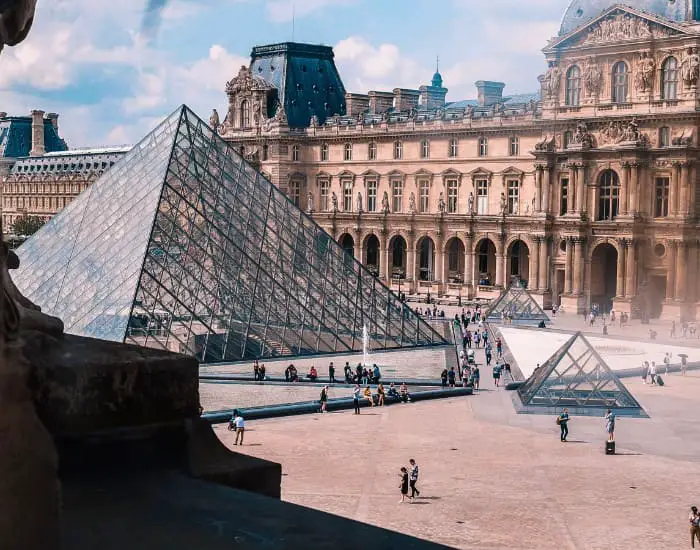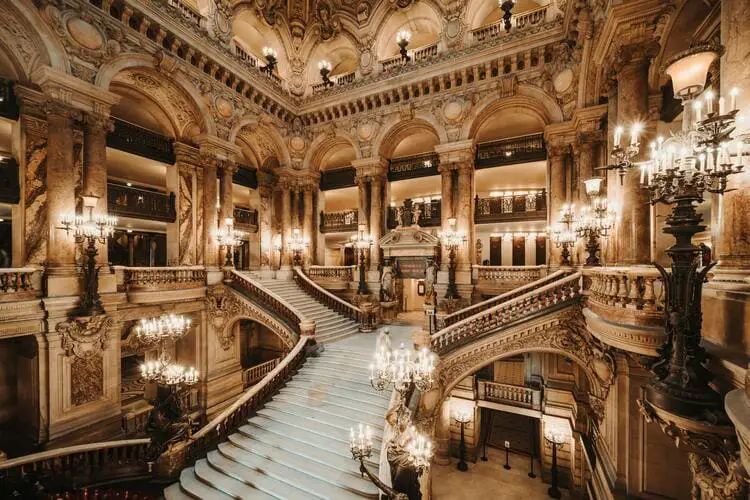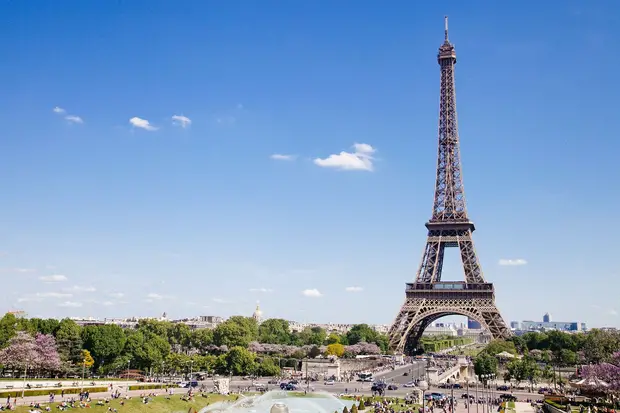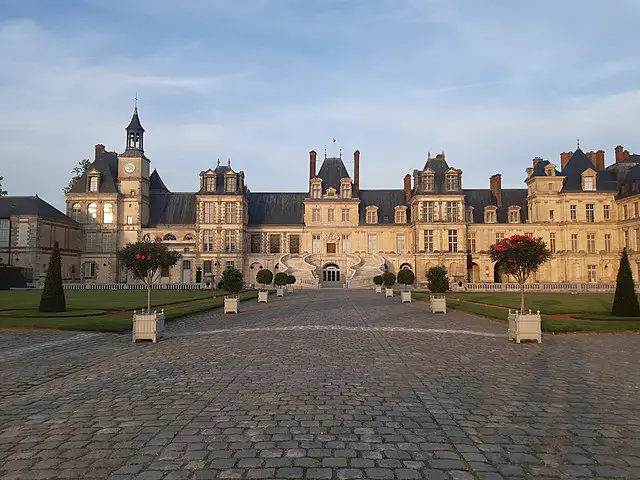In Paris, there are many monuments that have witnessed the extraordinary history of the city, and many constructions testify to this long-gone past. Some are famous and others are not; in many different districts, some are massive and others are humble, but they are all part of Paris’s and France’s history. I have selected the best landmarks to visit in the City of Lights.
First, let’s see where to locate them on a map:
1) Arc de Triomphe
Avenue Charles de Gaulle – 8th District
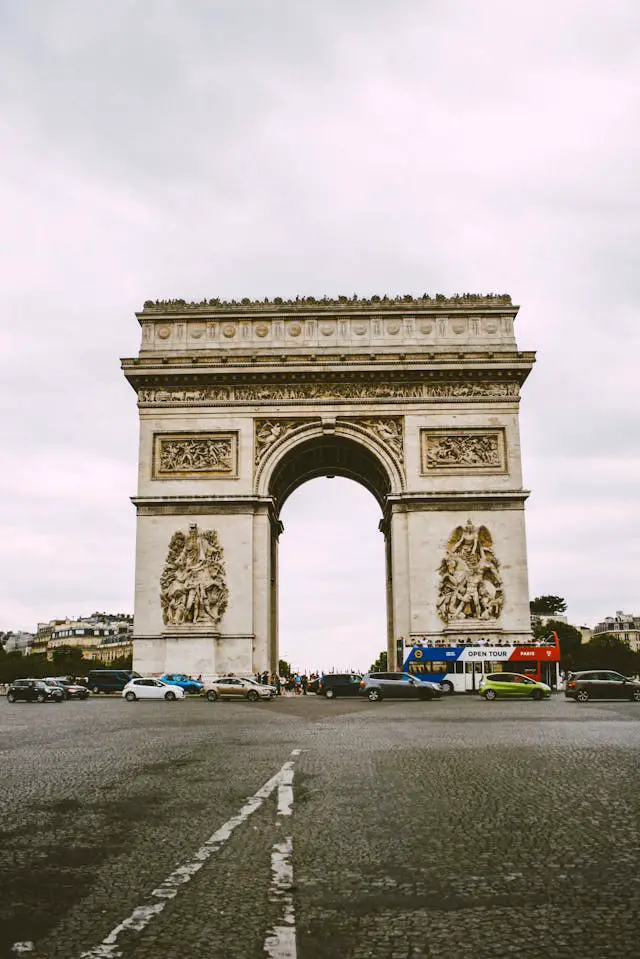
It is one of the most famous monuments in Paris. Built on the Place de l’Etoile, at one end of the Champs-Elysée, the Arc de Triomphe is one the biggest arches in the world.
It was built in 1806 to celebrate Napoleon Bonaparte’s victory in Austerlitz and was inspired by the Roman triumphal arch. However, it was designed on a much bigger scale than its model: it is 50 meters high, 45 meters long, and 22 meters wide. It stands as one of the most famous monuments in Paris.
Beneath the vault is the Tomb of the Unknown Soldier. Under a continual watch, an Eternal Flame is turned on each night at 6:30 p.m. If you choose to visit this glorious monument, you can climb to the summit, from which you have a panoramic view of Paris, be it day or be it night. Inside, a museum explaining the Arc de Triomphe’s history will complete your visit.
Rate:
Full rate: €17
Free for EU citizens under 26, disabled people and their attendants and the unemployed.
Book a visit to the Arc de Triomphe
2) Eiffel Tower
Champ de Mars, 5, avenue Anatole France – 7th district
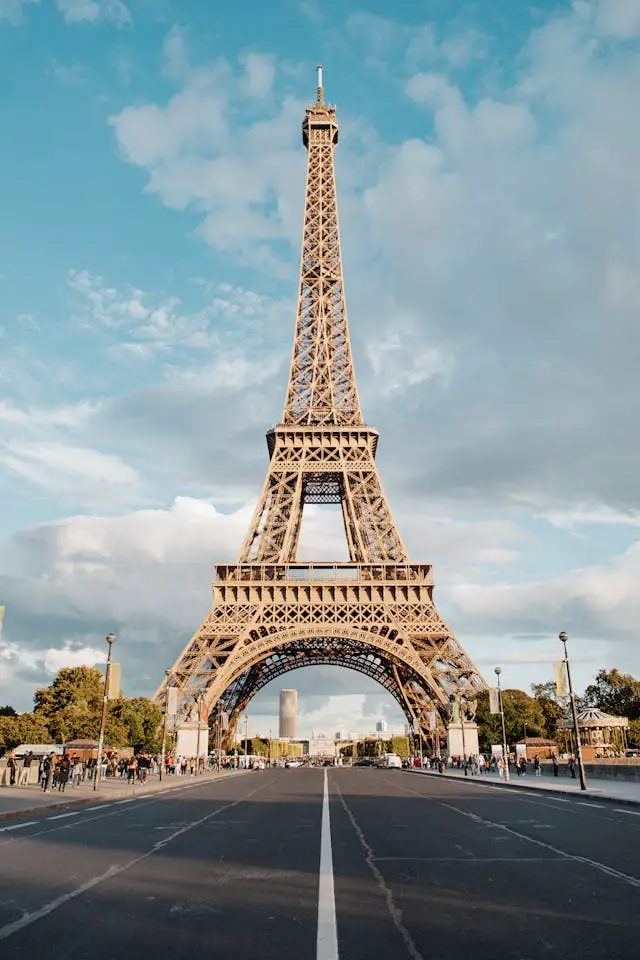
Of course, the Eiffel Tower is THE monument you have to see when you visit Paris. It has become the symbol of Paris. Initially built for Paris’ 1889’s World’s Fair, it became the icon of the city.
Looming over the city from its 312-meter height, the Eiffel Tower is visible from afar. After visiting the Tower itself, you can spend some time to admire the Champ de Mars and its garden at its feet.
The Eiffel Tower, quite obviously, attracts many visitors each day, and packs of swarming tourists are in a rush to admire it and have to queue up before getting in.
Fortunately, you can buy your tickets and cut the line instead of queuing up for hours.
When you go to the Eiffel Tower, you can climb up in two different ways: the bravest can use the stairs, and the others the elevator (which is also the only way to the third floor).
On the first floor, you will find shops; the Jules Verne is a beautiful high-class restaurant on the second floor; finally, the third floor offers one of the best views of Paris, and anywhere you look, you will see the beauty of the French capital.
Rates: From €14.50
Free for kids below 4 y-o
Book a visit to the Eiffel Tower
3) Basilica of the Sacré-Coeur
35, rue du Chevalier de la Barre – 18th district
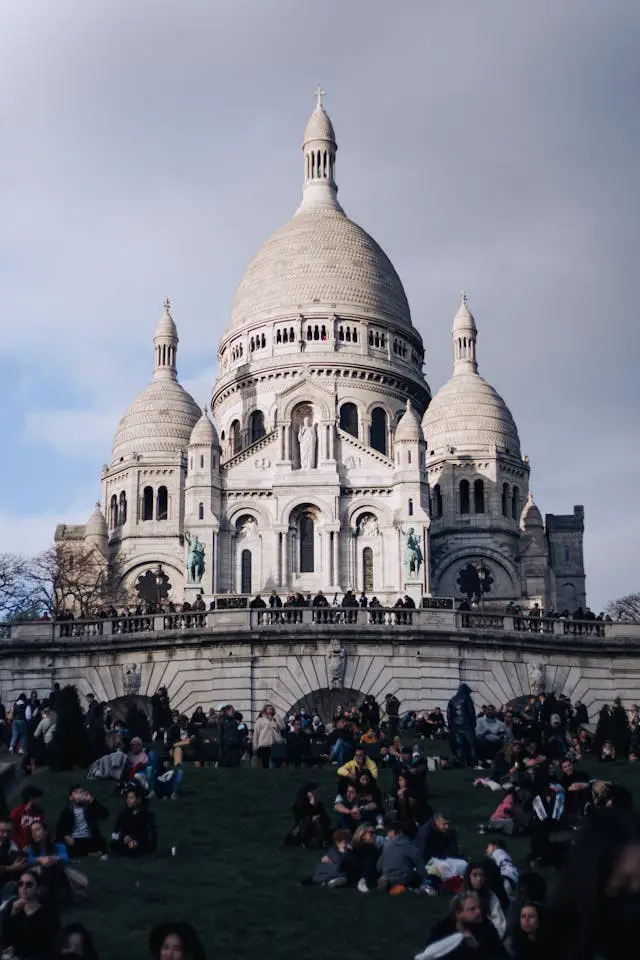
Atop the hill of Montmartre, the Basilica of the Sacré-Coeur is one of Paris’ emblematic monuments.
This building has one of the most astonishing views of Paris.
Nested upon its 130-meter-high hill, the basilica, built in a Romano-Byzantine style, is an architectural masterpiece.
It is composed of four minor domes and a central dome culminating at 83 meters.
The most impressive part of this monument is its giant bell, one the biggest in the world.
The Sacré-Coeur was built in 1873 after a decision of the French National Assembly to build a place to commemorate the victims of the 1871 war opposing France and Prussia.
Apart from the view, the building holds much charm as well, and when you enter you will be struck by the beauty of the 480m² mosaic on the floor. You can also visit the crypt.
Finally, if climbing the stairs of Montmartre is not enough, you can choose to go even higher to the dome of the Basilica and admire the best view of Paris from its summit.
Rates:
The entrance to the Basilica is free
Dome: €8; from 4 to 16 y-o: €5
Crypt: free 40-minute tour on Tuesday, Wednesday and Thursday afternoons
Free for those below 4y-o
For further information about the Basilica of the Sacré-Coeur, click here.
4) Army Museum – Les Invalides
129, rue de Grenelle – 7th district
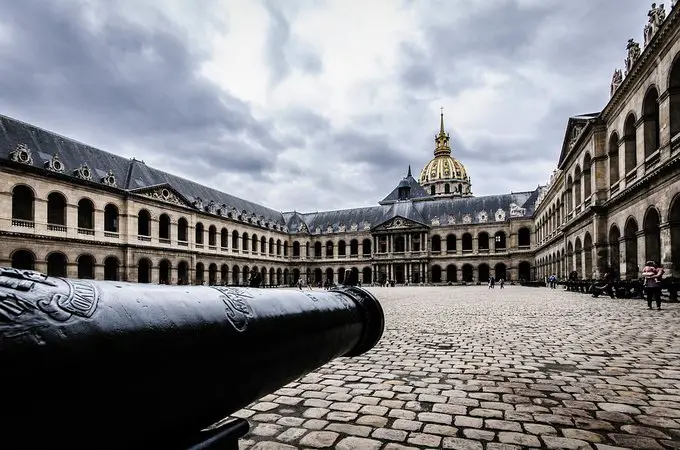
It was first created under Louis XIV to shelter the disabled soldiers of his army, but Les Invalides as we know it today was born in 1905.
It became the Army Museum and exhibits over 500,000 items over 8,000m².
This gigantic collection makes this museum the most important place of military history in France as well as one of the greatest in the world.
During your visit, you can admire the permanent collections of the museum, exposed in chronological order from Antiquity to World War II.
You will also find the Dome des Invalides (a church) and, inside, the heart of the Marquis of Vauban.
But what you came for must be the famous tomb of Napoleon Bonaparte the First, resting here beside his son Napoleon II, King of Rome.
Rates:
Full rate: €14
Reduced rate*: €11
*For veterans, reservists, large families; for everyone after 5pm
Free for EU citizens under 26 y-o
For further information about Les Invalides and the Army Museum, click here
Book your tickets to the Invalides
5) Notre-Dame de Paris Cathedral
6, place du Parvis Notre Dame – 4th district
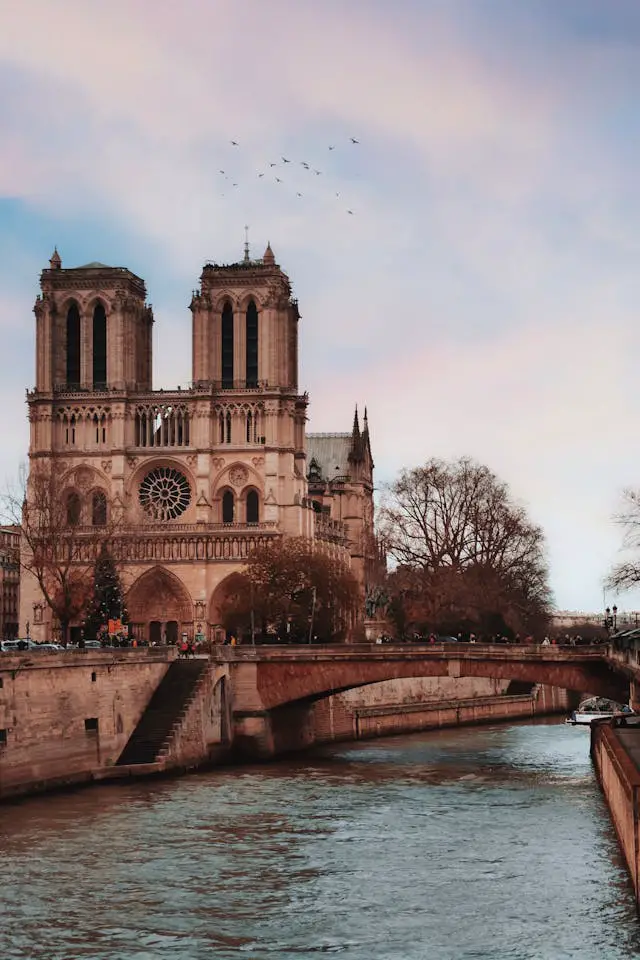
Located in the historic center of Paris, at the end of the Ile de la Cité, the Notre-Dame Cathedral is the most visited monument of the city.
Indeed, this architectural masterpiece shines over the entire district.
With its high towers, which inspired Victor Hugo in one of his novels, Notre Dame bears witness to the history of Paris.
Its construction began in 1163, and it took nearly two centuries to finish.
It is a must-see in Paris. The sound of the bells will guide you to it, with such charm that “it’s said to be the soul of Paris setting ablaze when they ring.” Victor Hugo, The Hunchback of Notre-Dame
Through the centuries, Notre-Dame often was at the heart of major historical events.
Including the wedding of Henry IV of France and Marguerite de Valois in 1572 and the funerals of the greatest of men, or the coronation of Napoleon Bonaparte in 1804, many important events in French history took place at Notre-Dame.
When you visit the Cathedral, you will learn of these historical nuggets and will probably fall in love with the 13th-century stained-glass and rose windows.
The indoor decoration and the 43-meter-high ceiling are gorgeous as well.
You can also see Notre-Dame’s treasures and climb up the stairs to enjoy the wonderful view from one of the towers, at no less than 69 meters in height.
Rates:
The entrance is free
Visiting the tower is free for citizens of the EU under 26 y-o, disabled people and their attendants, job seekers, and those receiving minimum social benefits
For further information about Notre-Dame de Paris, click here
6) Centre Pompidou
Place Georges Pompidou – 4th district
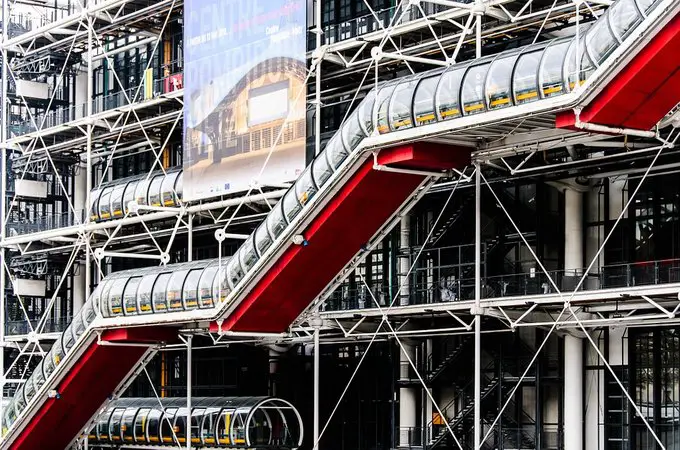
The Centre Pompidou is an architectural wonder designed by Renzo Piano and Richard Rogers.
It is a 20th-century building with a futuristic design that is now part of the 4th district’s identity.
The museum hosts various temporary art exhibits, such as Dali’s pieces, for example.
The outdoor escalators and the big colorful pipes make it an unmistakably unique building in Paris.
The Centre includes the National Museum of Modern Art, a worldwide reference for its collections of 20th and 21st century pieces.
There are different tributes to different arts, such as music, design, or cinema, in the Centre.
Georges Pompidou was President of France from 1969 to 1974 and wished to give French art a new place on the international stage and open it to the masses. Mission accomplished.
Rates:
Museum and exhibits: €15 (museum, exhibits, and view of Paris)
Reduced rate: €12
Free for EU citizens under 26 y-o, disabled people and their attendants, journalists…
Book a visit to the Centre Pompidou
7) Louvre
99, rue de Rivoli, 1st district
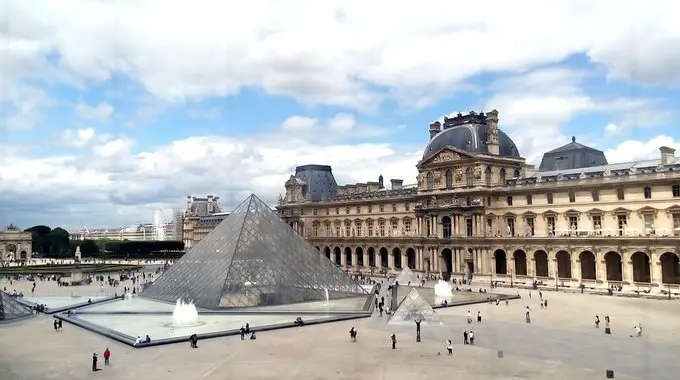
The Louvre is probably the most famous museum in the world.
It was the palace of the kings of France and, through its numerous collections, it allows you today to discover occidental art from the Middle Ages to 1848, as well as antique civilizations.
There are major sculptural masterpieces, such as the Winged Victory of Samothrace or the Venus de Milo, or paintings like The Raft of the Medusa by Géricault.
I advise you to prepare your visit by checking the Museum’s website: the Louvre is so big that you can easily get lost, both figuratively and literally.
And of course, you can admire the portrait of Lisa Gherardini, better known as the Mona Lisa, by Leonardo da Vinci.
La Gioconda is representative of the museum; it is a painting full of mysteries, just like the Louvre itself.
Rates:
Free for children under 18 and for EU citizens under 26
Full rate: €22
Book a visit to the Louvre Museum
For more information (prices, opening times, collections) on the Musée du Louvre, visit its official website.
8) Musée d’Orsay
1, rue de la Légion d’Honneur – 7th district
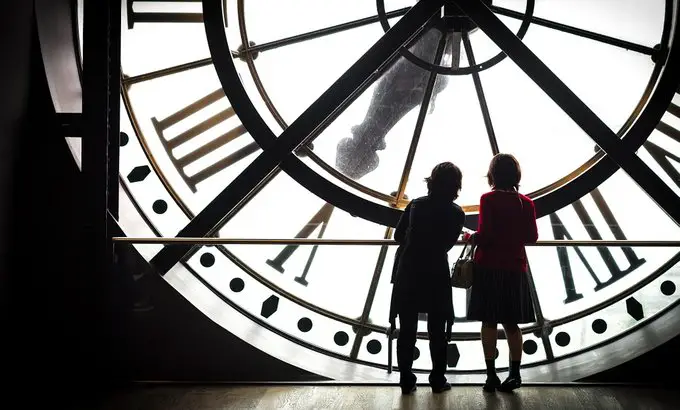
On the left bank, just in front of the Tuileries Garden, stands the Musée d’Orsay.
The museum occupies an old railway station built for the 1900 Paris World’s Fair 1900, which makes it an exceptional place for exhibits.
You can enjoy occidental art ranging from 1848 to 1914. While not as famous as the Louvre, the Musée d’Orsay also has a very impressive art collection.
It hosts the most important Impressionist and post-Impressionist art collection in the world, with more than 900 paintings.
Occasional temporary exhibits show off a particular artist’s work or artistic trend.
The Musée d’Orsay is a must-see, and even while hidden in the shadows of the Louvre, it is an essential display of art in France.
Rates:
Free for children under 18 and for EU citizens under 26
Full rate: €16
Book a visit to the Orsay Museum
For more information (prices, opening times, collections) about the Musée d’Orsay, visit its official website.
9) Palais Garnier
8, rue Scribe – 9th district
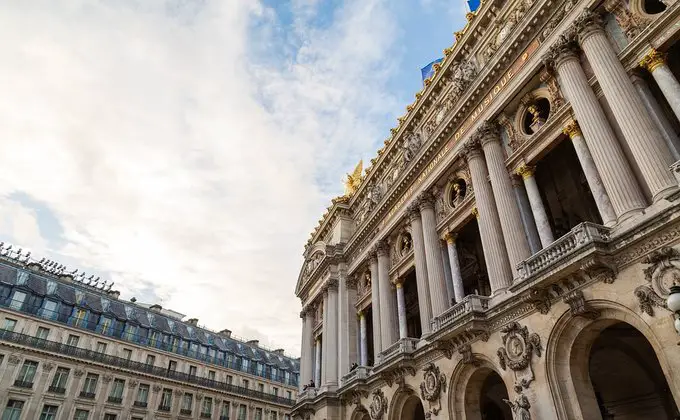
Looming over the Place de l’Opéra, the Palais Garnier, also called Opéra Garnier, is definitely a must-see for anyone visiting Paris.
Its architecture and design were elaborated during Napoleon III’s reign, hence the typical 19th Century style of the building.
Inside, the statues of two women holding torches welcome the visitors.
You can then admire the Bassin de la Pythie and the Grand Escalier leading to the famous vault of the Palais Garnier.
The vault is over 30 meters high and is both colorful and bright due to the various types of marble it’s made of.
You can also discover the history of this sanctuary of Parisian art.
The Palais also organizes events about opera and fashion.
Finally, the Palais Garnier’s auditorium is one of the most beautiful in the world.
Rates:
Full rate: €15
Reduced rate: €10
Free for job seekers and those under 12 years old
Book a visit to the Opéra Garnier
10) Place Vendôme
356, rue Saint-Honoré – 1st district
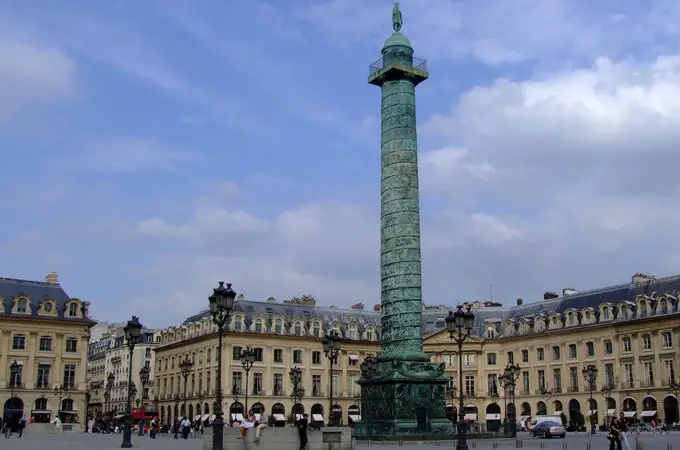
This square is very typical of classical French urbanism, with the famous Vendôme Column erected in its center in 1810.
It is also called the Austerlitz column, and it stands in the 1st district panorama, with a statue of Napoleon dressed as Caesar on the summit.
It is considered to be one of the most luxurious squares in Paris.
Designed by Jules Hardouin-Mansart, it shines upon the whole world.
As a center of French jewelry craft, and with the Rue de la Paix and its many couturiers, it symbolizes French refinement.
Rate: Free
11) Panthéon
28, Place du Panthéon – 5th district
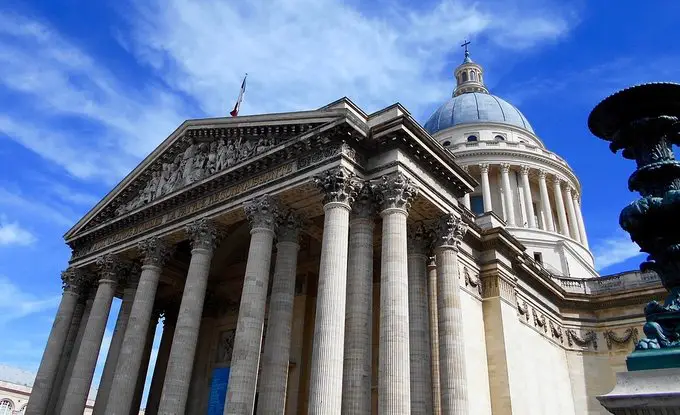
The Panthéon stands proudly in the heart of the Latin Quarter. Atop the hill of Montagne Sainte-Geneviève, it looks down upon the 5th district.
More or less inspired by the Pantheon of Rome, the Parisian Pantheon was built as a memorial.
Indeed, the crypts are home to the graves of the greatest French celebrities who marked the country throughout history.
You will find such people as Rousseau, Voltaire, or Alexandre Dumas.
A short text sums up the life and work of those who rest here.
When you come inside, you can also discover the Foucault pendulum, invented by Léon Foucault in 1851, which has once proven that the Earth does, indeed, rotate.
Rates:
Full rate: €13
Free for citizens of the EU under 26 y-o, disabled people and their attendants, job seekers and those receiving minimum social benefits
For more information about the Panthéon, click here
12) Grand Palais
Avenue Winston Churchill – 8th district

Next to the Champs-Elysées, the Grand Palais has fascinating dimensions: more than 77,000m² are dedicated to various exhibits, which is equal to more than seven soccer fields.
It was built for the 1900 World’s Fair and is now one of the main exhibition centers in France.
The symbol of the Grand Palais is its gigantic 45-meter-high glass roof, in the same spirit as the rest of the building.
The architecture is typical of the eclectic nature of the “Beaux-arts style,” and this building alone sums up the tastes of the Belle Époque.
Besides its exhibits, the Grand Palais hides many other nuggets, such as the beehives on the roof placed there to increase awareness about how much such insects are essential to life on Earth.
Rates: Depending on the exhibit
For further information about the Grand Palais, click here
13) Place des Vosges
Pl. des Vosges, 75004 Paris

Created under Henri IV, the Place des Vosges is the oldest square in Paris and a model of 17th-century town planning. Its red brick pavilions and elegant arcades make it a unique and historic site.
Today, it is a popular place for strolling, lined with art galleries, boutiques and cafés, where you can also discover Victor Hugo’s house.
Stroll through this perfect square of gardens, an oasis of tranquillity in the heart of the Marais.
Access to the Place des Vosges is free.
14) Moulin Rouge
82 Bd de Clichy, 75018 Paris
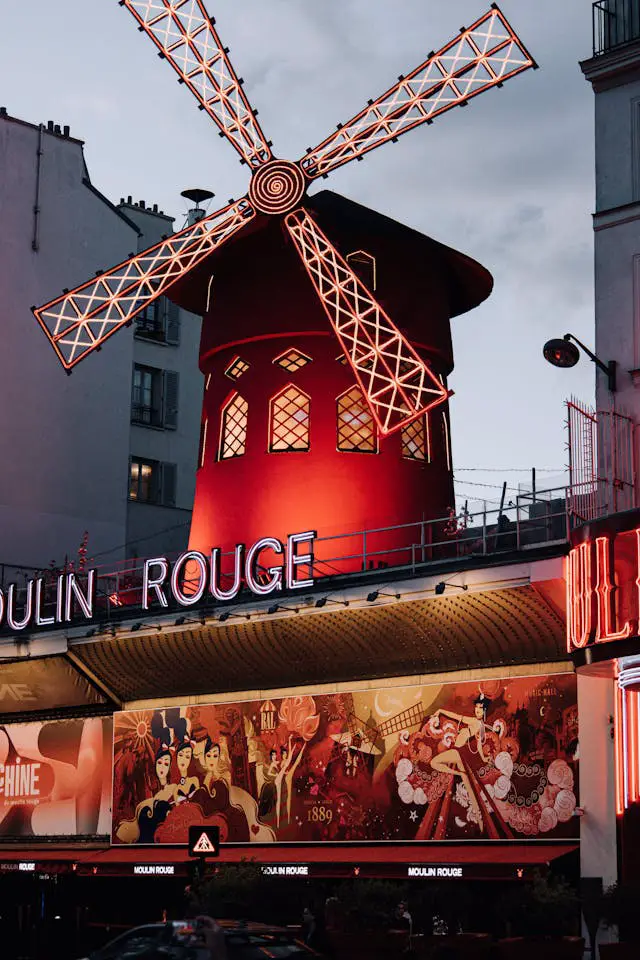
Built in 1889, the Moulin Rouge has become one of the most famous cabarets in the world. With its famous illuminated red mill, it embodies the festive spirit of Montmartre and the Belle Époque.
Today, it hosts sumptuous shows, the most famous being the ‘Féerie’, combining cancan dancers, feathers, rhinestones and sequins.
During your visit, let yourself be seduced by the unique atmosphere of this emblematic Parisian venue.
Book your tickets for an evening at the Cabaret
Prices :
Shows and dinners from €100 (variable depending on the package chosen).
15) Canal Saint-Martin

Built under Napoleon I, the Canal Saint-Martin crosses Paris from the Bassin de la Villette to the Seine. This picturesque spot is famous for its locks, swing bridges and shady promenades.
Today, the canal is a popular place to relax, lined with trendy cafés and boutiques, ideal for a romantic stroll or a picnic by the water.
You can also enjoy a cruise along the canal to discover Paris from a different angle.
Access to the canal is free.
Cruises are also available on the canal.
16) Montparnasse Tower
33 Av. du Maine, 75015 Paris

Built in 1973, the Montparnasse Tower is one of the few skyscrapers in Paris and offers an exceptional panoramic view of the city. Standing 210 meters high, it offers a 360-degree view of Paris.
The 56th floor houses a panoramic terrace where you can enjoy an unforgettable view of the Eiffel Tower and the main monuments of Paris.
Rate :
Full rate: €21 (online)
Reduced rate*: €13.50
*For young people aged 12 to 18, free for children under 4.
To book your tickets for the Montparnasse Tower.
17) Père Lachaise cemetery
Cimetière du Père Lachaise, 75020 Paris
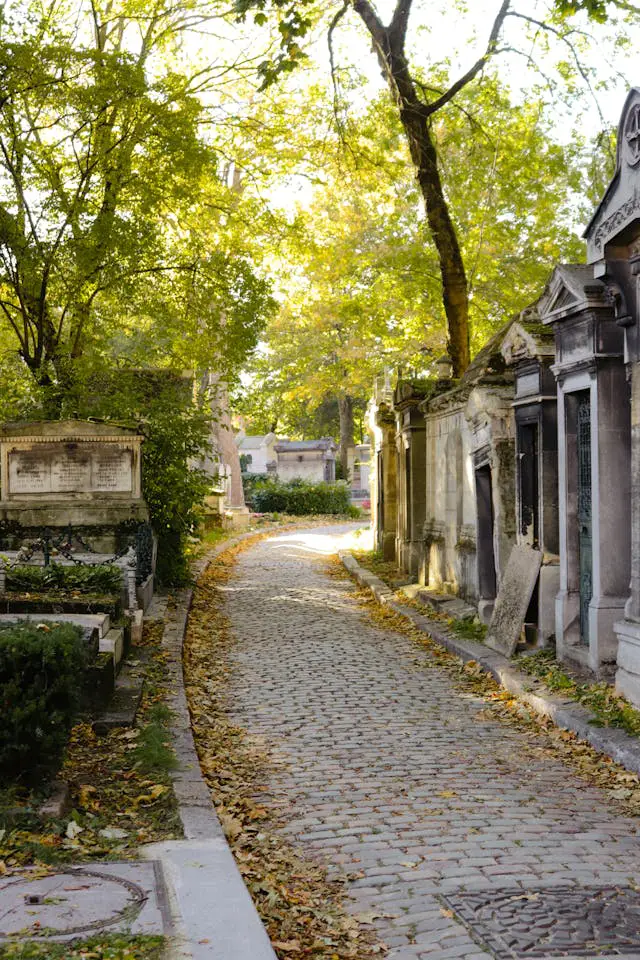
Created in 1804, Père Lachaise Cemetery is the most famous in Paris, attracting millions of visitors every year. This place, steeped in history, is home to the graves of such famous figures as Oscar Wilde, Jim Morrison, and Édith Piaf.
The alleys are lined with statues and mausoleums, making it a peaceful place for contemplation and meditation.
Admission to the cemetery is free.
Guided tours are available to learn more about the cemetery’s history and the personalities buried there.
For more information on tours, visit the Père Lachaise cemetery website.
18) Palace of Versailles
Place d’Armes, 78000 Versailles
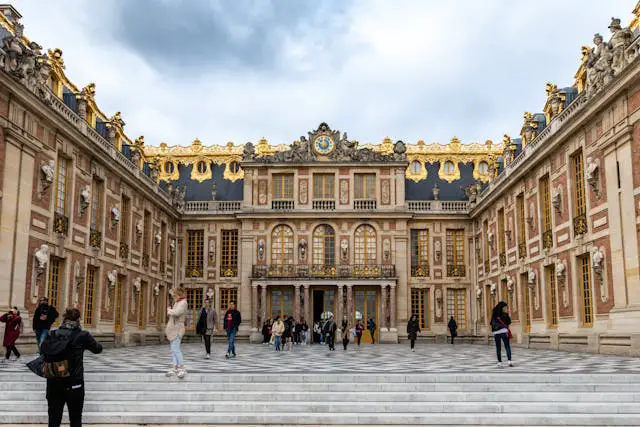
Built under Louis XIV, the Palace of Versailles is a symbol of French luxury and royal power. With its 2,300 rooms, formal gardens and famous Hall of Mirrors, it is one of the world’s most beautiful heritage monuments.
Today, the palace is a museum of French history and a major cultural attraction.
During your visit, discover the royal flats, the Royal Chapel, the Grand Trianon, as well as Le Nôtre’s sumptuous gardens.
Rates:
Full rate: €21
Reduced rate*: €13
*For young people aged 18 to 25, free for under-18s.
Book your ticket for the Palace of Versailles
19) Pont Alexandre III
Pont Alexandre III, 75008 Paris
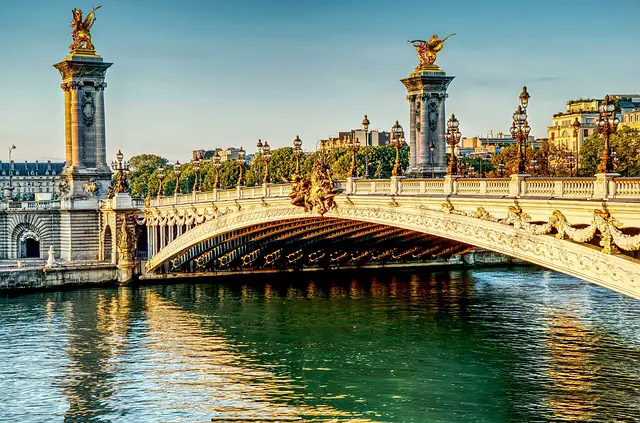
Originally designed for the 1900 Universal Exhibition, the Pont Alexandre III embodies the alliance between Paris and Imperial Russia. This emblematic bridge of the Belle Époque, adorned with gilded sculptures and art deco lamp posts, links the Invalides to the Champs-Élysées.
It symbolizes the splendor and elegance of Paris and is one of the capital’s most beautiful bridges.
As you cross, you’ll be able to admire the breathtaking views over the Seine and the surrounding monuments, while getting a close-up view of the magnificent Pegasus statues and caryatids.
Crossing the bridge is free of charge.
20) Sainte-Chapelle
10 Bd du Palais, 75001 Paris
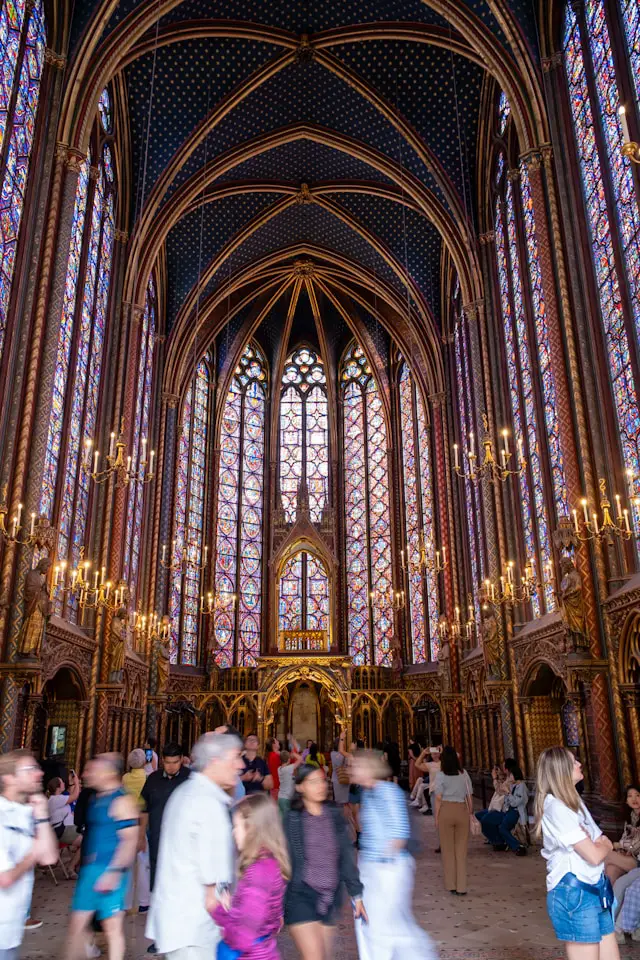
The Sainte-Chapelle, built under the reign of Saint Louis in the 13th century, is a masterpiece of radiant Gothic art. This architectural gem in the heart of the Ile de la Cité was designed to house the precious relics of the Passion of Christ.
The monument is famous for its magnificent stained glass windows, which cover more than 600 m² and tell the biblical story in 1,113 scenes.
During your visit, you can admire these spectacular stained glass windows, which transform the chapel into a veritable mosaic of light and color.
Rate:
Full rate: €13
Combined Sainte-Chapelle – Conciergerie rate: €20
*For young people aged 18 to 25, free for under-18s.
To book your ticket for the Sainte-Chapelle
21) Saint-Jacques Tower
Square de la Tour Saint-Jacques – 1st district
Voir cette publication sur Instagram
At the heart of the 1st district stands a prestigious building you can see from afar: Saint Jacques Tower.
While not very well-known in Paris, the tower truly is magnificent.
Built in a Gothic style, it is the only remnant of the Saint-Jacques-de-la-Boucherie church.
From its 62 meters, the tower has been an important site of the right bank since the 16th century.
The guided tour lasts about 50 minutes, during which you will climb the steps of this monument.
The visit to the tower begins with its history, its origin, and the difficult construction.
After several stops during the climb to learn of the secrets of the tower, partly destroyed during the French Revolution, you can enjoy the astonishing view from the top of the tower.
Rates:
Full rate: 10€
More information about Tour Saint-Jacques
22) La Conciergerie
2, boulevard du Palais – 1st district
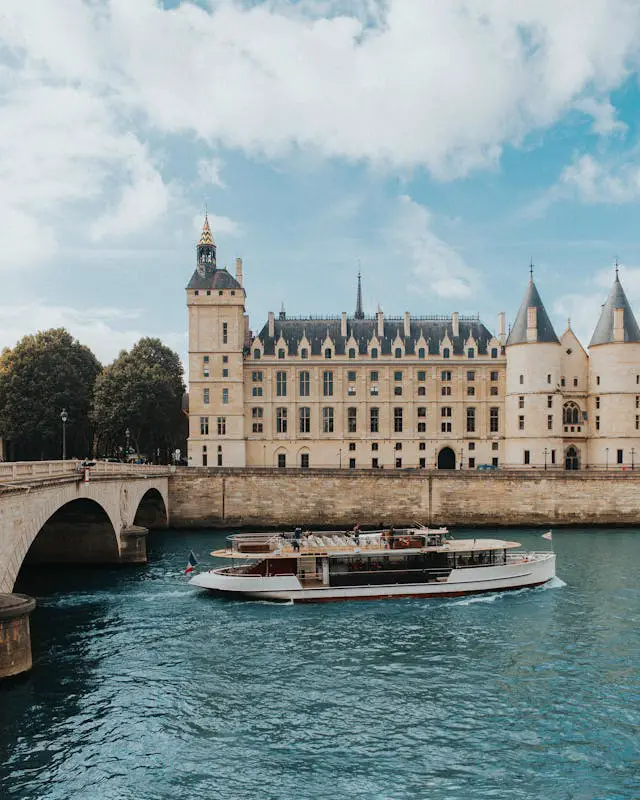
This building in the heart of Paris and the 1st district has certainly witnessed history.
It is a beautiful palace built in the style of Gothic architecture, a remnant from past times.
This monument was rebuilt under Philip IV the Fair’s reign at the beginning of the 14th century.
From this original building, remains only the Salle des Gardes (Guards Room), the Salle des gens d’Armes (Hall of the Soldier), and the kitchens, all of which are a valuable sample of 14th-century architecture.
During the visit, you will learn the full history of this building, which is one of the oldest in Paris. It was first a king’s palace, then a jail, most notably during the French Revolution when Marie-Antoinette was locked up here.
A little-known place well worth a visit.
Rates:
Full rate: €13
Free for citizens of the EU under 26 y-o, disabled people and their attendants, job seekers and those receiving minimum social benefits
Book a visit to the Conciergerie
23) Japanese garden of the Buddhist Pantheon
19, avenue d’Iéna – 16th district
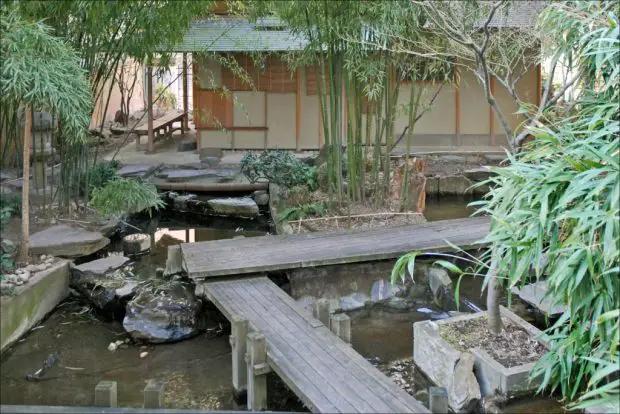
Hidden from the streets and the crowds in a small backyard of the 16th district, a Japanese garden awaits your visit.
Just behind the Guimet Museum and its important collection of Asian art, you can visit this unique place in Paris.
It is part of the Buddhist Pantheon (a part of the Guimet Museum), and this garden will amaze you.
It is free to enter, with a surface of 450m². It was built during the renovation of the building in 1991.
You will see giant bamboos, stone pavements, and a wooden bridge over a little stream.
Everything you need to relax is right there.
On the heights of the garden, you can admire the lodge designed by Japanese craftsmen, and you may even try out a Tea Ceremony.
Rates: Free visit
24) Catacombs
1, Avenue du Colonel Henri Rol-Tanguy – 14th district
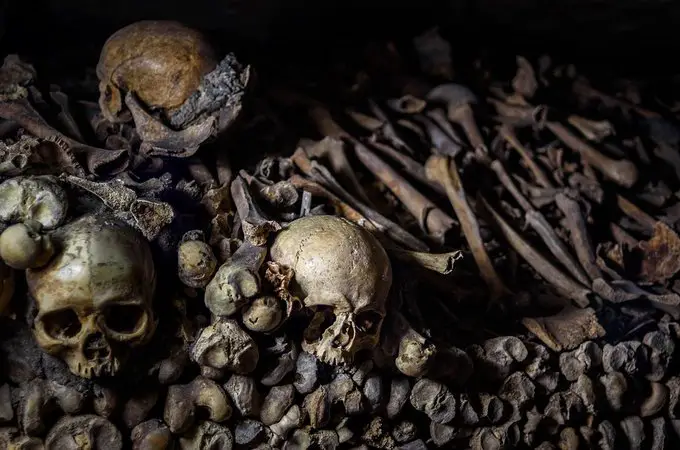
The Catacombs are huge Parisian ossuaries, stretching underground over 11,000 m², inspired by the Catacombs of Rome.
The entry is Place Denfert-Rochereau.
Six million bones from different Parisian graveyards rest in this maze of 1.7km.
The vault is 1.80m high and the temperature is about 14°C (57°F).
The tour is unsuitable for people with heart or respiratory problems, those of nervous disposition, and young children.
An original and fascinating tour for sure!
Please note that the exit is 36, rue Rémy Dumoncel.
The Paris Catacombs are the most important necropolis in the world.
The remains of 6 million Parisians are stored here.
You will discover the Cemetery of the Innocents, with all its carefully organized bones.
Dozens of other rooms follow, paying tribute to the dead, like the room dedicated to the victims of September 1792 or another only for those guillotined on the Place de la Concorde, such as Louis XVI and Marie-Antoinette.
Rates:
Full rate: €30
Reduced rate*: €23
*For large families, teachers, young people (18 – 26 y-o)…
Free for those under 18, art students, disabled people and their attendants, job seekers, and those receiving minimum social benefits
Book a skip-the-line ticket to the Catacombs with an audioguide included
25) The Wall of Love
place des Abbesses – 18 district
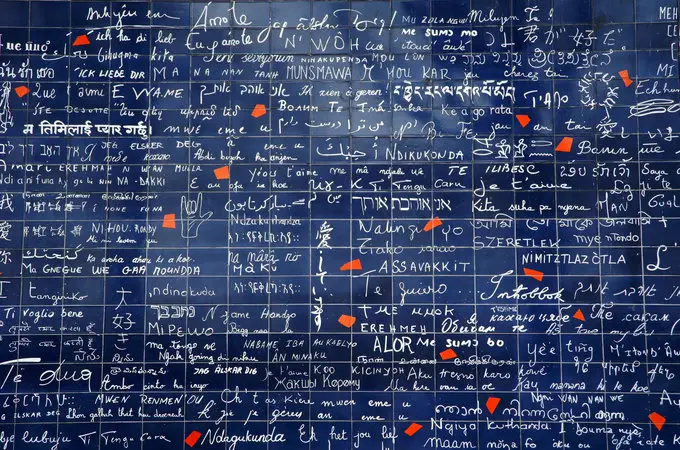
The Wall of Love (in French, Le Mur des Je t’aime) was designed by Frédéric Baron and Claire Kito, on a square Place des Abbesses.
This place is a must-see for every couple in Paris.
Just like the Pont des Arts and its padlocks (which have been taken off on June 1st, 2016), the Wall of Love in itself is a symbol of Love.
Indeed, with its 40m² and 612 tiles, 311 “I love you”s are written in 250 languages.
It is a real tribute to love on Montmartre; according to the artists, the speckled wall with red tiles symbolizes the broken heart of humanity that the wall tries to repair.
An original site, away from the usual agitation of Paris.
Rates: Free
26) Statue of Liberty
L’Île aux Cygnes – 15th district
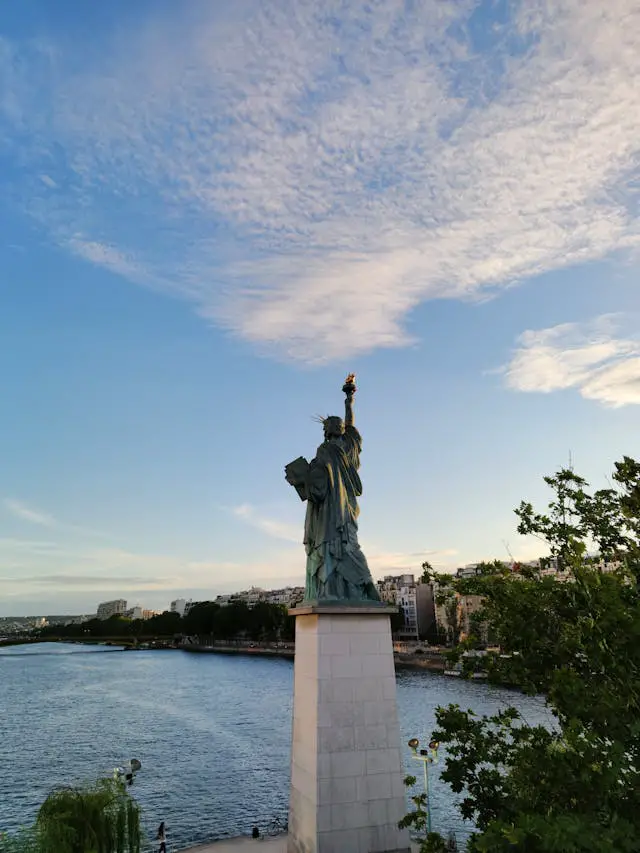
No, you’re not dreaming, this is indeed the Statue of Liberty in Paris… or rather, a smaller reproduction.
Much smaller than the original, this Parisian Statue of Liberty stands on the Île aux Cygnes, near the Pont de Grenelle (others exist in Paris: will you find them?).
Only three years after its big sister, this one was built in 1889.
Its back used to be facing the United States, which did not please Auguste Bartholdi. It was then rotated westward, looking at New York in 1937, for the World’s Fair, 33 years after the artist passed away.
Rates: Free
27) Arènes de Lutèce
49, rue Monge – 5th district
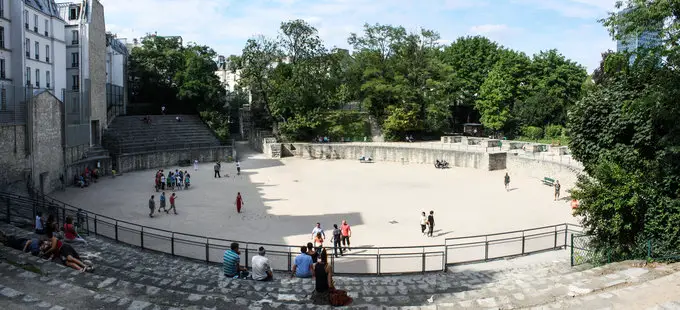
This monument is one of the oldest in Paris; it was built during the 1st century.
The Arènes are now free to access for everyone, every day from 8:30 a.m. to 5 p.m. in Winter, and until 9 p.m. in Summer.
This old amphitheater in the Latin Quarter could host up to 15,000 spectators.
Current visitors can still see where the stage used to be.
This is, with the Thermes de Cluny, one of the only remnants of the Gallo-Roman era in Paris.
Today, the Arènes are a famous place to visit and spend time on a sunny day, playing boules, soccer, or taking a nap in the grass.
You can also admire a birdhouse, which allows children to discover unknown birds.
Rates: Free
I aim to share my tips and recommendations for the beautiful country of France. My goal is to help you plan your next adventure, whether it’s a weekend getaway or a once-in-a-lifetime trip. From finding the best hotels and restaurants, to discovering unique activities and sights, I’ve got you covered!

